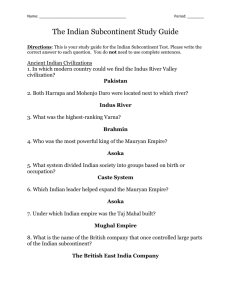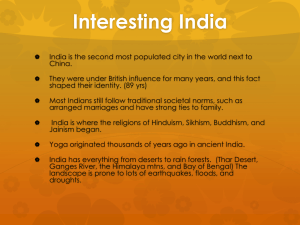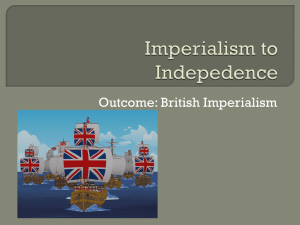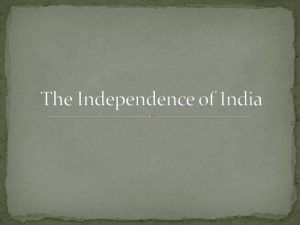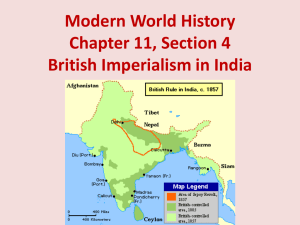India
advertisement
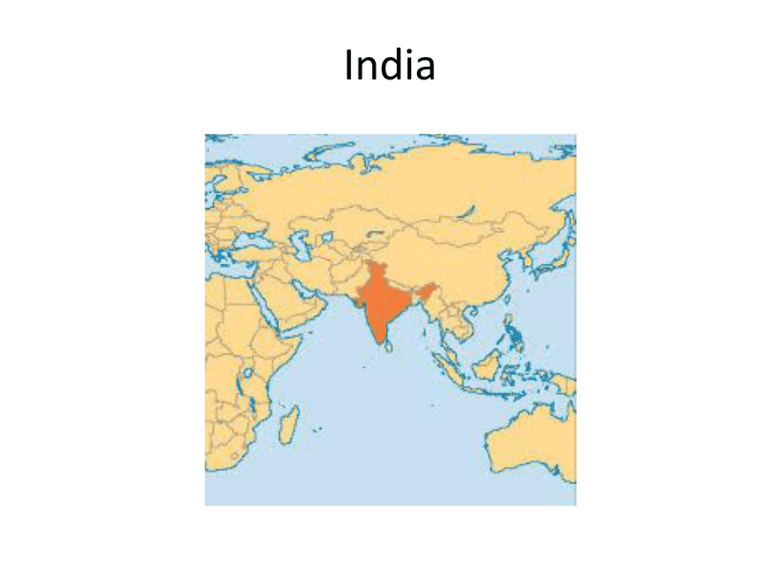
India Geography Geographythe Indus River floodsThe twiceHimalaya a year Mountains predictably in the North and Northeast of India create a barrier. What impact does India is a Peninsula withnatural the Himalaya mountains in the Norththis and have NE (a natural on the Indus River Valley? barrier) Mountains protect from invading Monsoons, seasonal winds,forces bring and create isolation predictable rains Indus River Valley The Indus river valley is a gentle river that predictable floods every year. The second most important river is the Ganges river. The Ganges has become sacred to the Hindus of India. Ancient India Not much is known about ancient India because we have not translated their language. However, the Indus River civilizations did have well planned cities. Mohenjo-Daro and Harappa demonstrate the grid pattern, well organized cities They even developed plumbing and sewer systems Indian contributions Established long lasting trade with the Middle East and Egypt (precursor to the Silk Road) First to grow and weave cotton. As other civilizations Hinduism The main religion of India today is Hinduism. Hinduism has no founder, but was developed over generations of cultural diffusion. Main Beliefs: -Reincarnation -Caste System (Karma and Dharma) -Ganges River -Moksha Maurya and Gupta Only Indian dynasties to unite the Indian subcontinent The Gupta dynasty experienced a Golden Age of cultural and intellectual achievements based on Hinduism. Gupta India: -centralized government -Caste system and Hinduism ruled society -Arabic Numerals and Zero Silk Road India is located in the middle of the Silk Road trade route connecting China and the Middle East. India contributed cotton, spices and other goods to the trade route. Age of Exploration Europeans wanted to gain direct access to the Spice markets of India. They could not pass through the Islamic world so they began exploring by sea Imperialism As European nations industrialized they struck out in search of raw materials and new markets India was claimed by the British. The Indians were used for cheap labor and forced to grow cash crops. The British followed mercantilism. The British forced Indians to grow Poppy (Opium) which they sold to China Sepoy Rebellion Sepoys were Indians in the British military. The British took several unpopular steps and the Sepoys rebelled: -Troops could be sent anywhere to fight -Widows were allowed to remarry -Sati was outlawed -Bullets dipped in animal fat Thousands of Sepoys, Indians, and British colonists were killed Indian Independence During WWI and WWII Indians fought for the British and allies, hoping to be rewarded by gaining their freedom. After the wars the British maintained control to make money to pay off war debts. The Indian people quickly grew impatient waiting for independence and began meeting. The Amritsar Massacre: peaceful demonstration turns deadly when British troops fired into unarmed Indians Mohandas Gandhi After years of abusive Imperial control the Indian people demanded trade. Mohandas Gandhi became a leader for Indians, but stressed passive resistance and Civil Disobedience He was later killed during the partitioning movements Partitioning When the British agreed to free India in 1947, they first partitioned the territory. They split India into Pakistan and India Pakistan: Muslims India: Hindus The transition, though mostly peaceful, resulted in the movement of millions Pakistan, Bangladesh and India The eastern portion of Pakistan later separated and became Bangladesh. Tensions remains between the three nations, especially now that all have developed nuclear weapons India today India is home to the second largest population on earth, with nearly 1 Billion people. It is predicted to overtake China by 2030. India has centers of industrial growth, factories and modernization. However, much of India is still rural and based on traditional ways of life.


